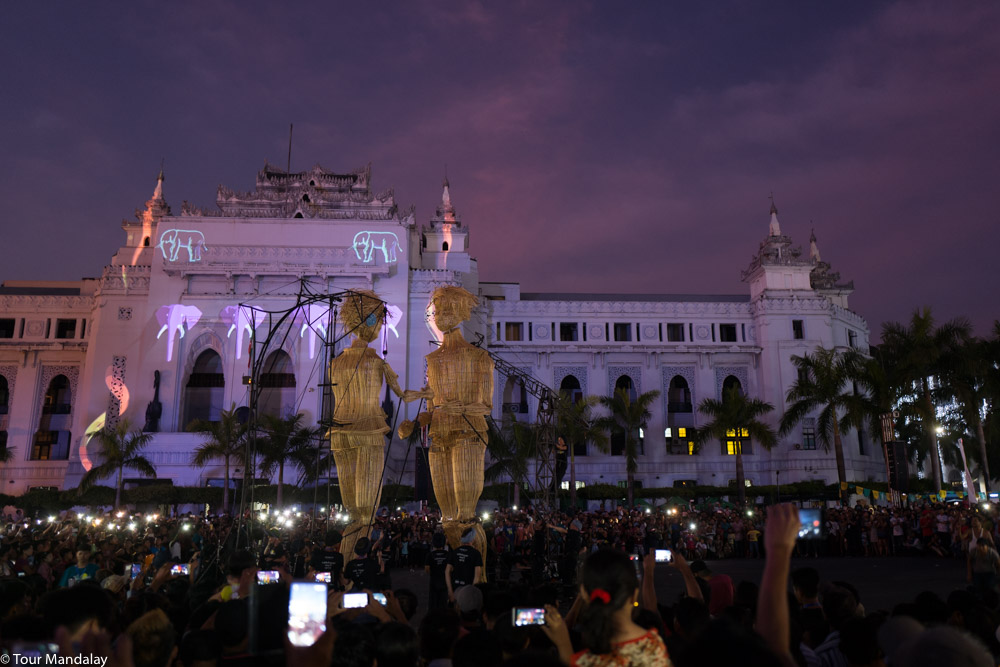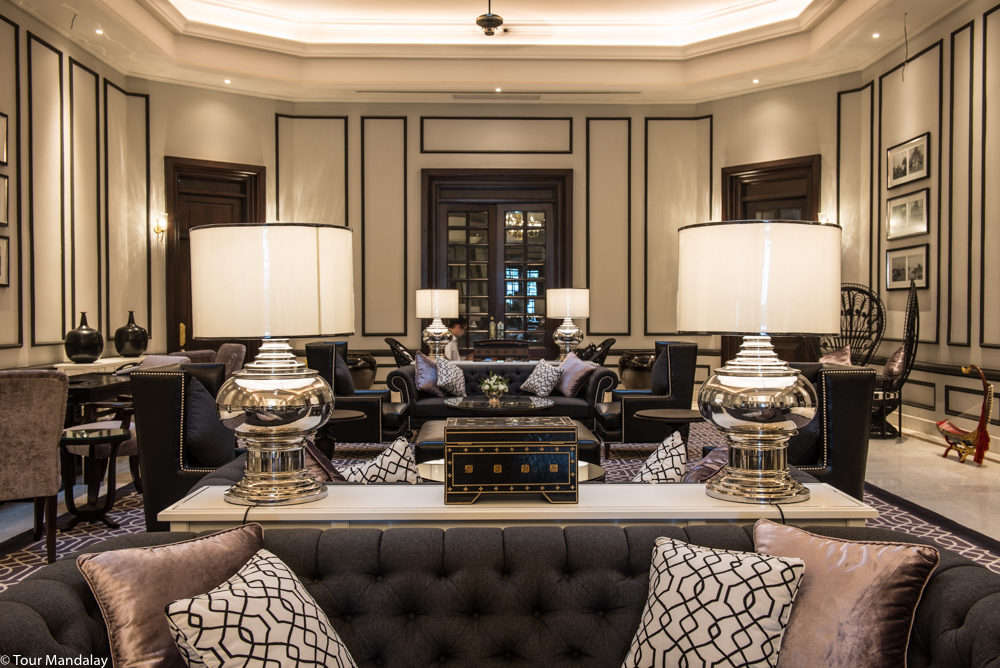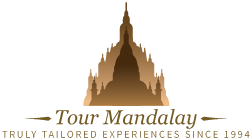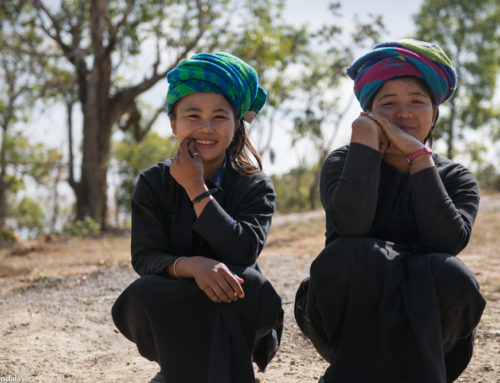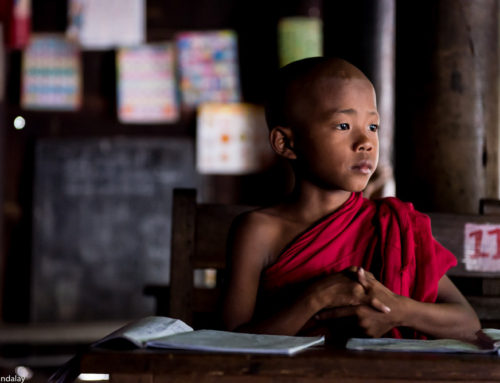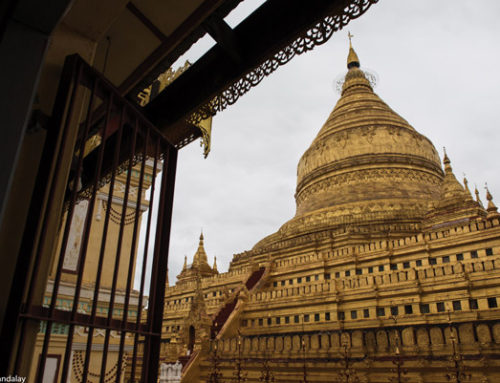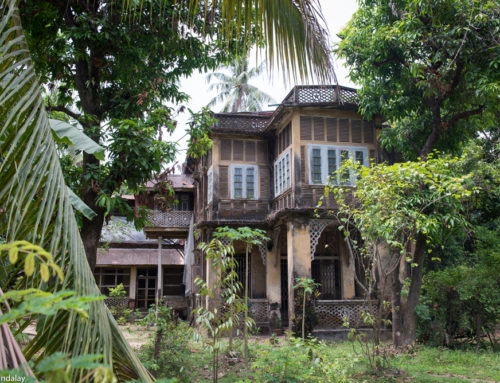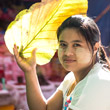Itinerary overview
Just under two weeks in duration, The Responsible Seven itinerary aims to show off and support some of Myanmar’s best responsible tourism projects, social enterprises, training restaurants and talented local entrepreneurs. We also hope it will help bring awareness to environmental issues such as the drought, deforestation and pollution caused by uncontrolled development around Inle Lake, the continued use of elephants for logging, and the fatal impact electric fishing practise is having on Myanmar’s endangered Irrawaddy dolphin population.
Day 1 - Yangon (iDiscover / Shwedagon / Shwe Sa Bwe) Shortly after checking through immigration you’ll be met by a representative of Tour Mandalay and escorted directly to your hotel. If arriving on an early morning flight we would recommend making use of the iDiscover’s self-guided walking app (available for both Anroid and Apple). Out of the four featured itineraries, we feel the Secretariat & beyond itinerary provides one of the best overviews. Starting at the majestic Secretariat building, you’ll wind your way through the heart of downtown, passing by myriad vine covered crumbling colonial facades, bustling local eateries, art galleries and lively streets. A benefit of using this app is that, other that using a taxi to get there, exploring won’t require the use of a car and iDiscover make a concerted effort to feature small and independently run businesses. A giant puppet performance (arranged by the Institut Français de Birmanie) outside Yangon City Hall in 2016 Reconvene with your guide later this afternoon to explore what Rudyard Kipling described as, “A golden mystery that upheaved itself on the horizon – a beautiful winking wonder that blazed in the sun”. The 99-metre tall Swedagon Padoga is the country’s most famous landmark; one that we believe looks extra impressive at sunset. The current hti (a golden umbrella that adorns the top of pagodas) is decorated with approximately 85,000 jewels, with the centerpiece being a 76-carat diamond. History and opulence aside, the highlight for most is brushing shoulders with the people as they go about paying their respects to Shwedagon itself, and the 150 smaller pagodas and shrines than surround. A dinner reservation will be made at Shwe Sa Bwe this evening (PLEASE NOTE: This meal is not included). Founded by Francois Stoupan in early 2013, Shwe Sa Bwe is a hotel and restaurant training center which aims to provide training to financially disadvantaged Myanmar youth looking to pursue a career in the country’s hospitality industry. Skip breakfast at the hotel this morning and enjoy an obligatory bowl of freshly cooked mohinga (fish broth soup with rice vermicelli) at Rangoon Teahouse (PLEASE NOTE: This meal is not included). This will also be a great opportunity to try some laphet yay (Myanmar tea), traditionally served with sweet condensed milk. Just above Rangoon Teahouse you’ll find Hla Day, a social enterprise that works with Myanmar artisans, disadvantaged groups and small local businesses to design, develop and sell quality handmade products with a contemporary twist. Being located on Pansodan Road, Yangon’s grandest city stretch, you will be perfectly situated to explore some of the city’s downtown core on foot. Just a stone’s throw away you will find Maha Bandula Park, the Yangon Region Court, Yangon City Hall and Sule Pagoda. Interestingly, this was made the center of Yangon by Lt. Alexander Fraser of the Bengal Engineers, who was the person responsible for creating the present street layout of Yangon shortly after the British occupation in 1852. After looping the park, we will then walk past the Yangon Stock Exchange building, through Bank Street and onto the once extremely prosperous Strand Road. The highlight here is the 1901-built Strand Hotel, described by John Murray (a famous British author) as “the finest hostelry East of Suez”. Inside the recently renovated Strand Hotel We will then walk one and a half blocks north to the LinkAge restaurant and art gallery, a vocational training restaurant where street and marginalised youth are taught essential hospitality skills (PLEASE NOTE: This meal is not included). To get a true sense of Yangon life, we will next take a short journey on the Yangon Circle Line. Built by the British over 100 years ago, this is still the cheapest and most time efficient way of connecting with Yangon’s outer suburbs. Time permitting, alight at a local market before driving back to the hotel by car. Transfer to the Yangon domestic airport this morning for a direct flight to Loikaw, the capital of Kayah State. Shortly after being greeted by our ITC (International Trade Centre) recognised local partner, you will be transferred to the home of a local artisan to learn about the production of Kayah sausage. Cooking enthusiasts may wish to try their hand at making their own. Next stop is the Loikaw Weaving and Vocational Training Centre. Start by exploring the centre’s luscious organic garden; here you will learn about the origin of the natural colours used in Kayah clothing, the dyeing process and traditional weaving techniques. We will then travel by car to Hta Nee La Leh, a small animist village located approximately 45 minutes away. A local representative will greet us on arrival to provide a short overview of the village, its people, history and customs. Having surely worked up an appetite, a barbeque lunch will be prepared and served inside a resident’s home nearby. One of Hta Nee La Leh village’s most distinct features is its Kayhtoebo, a traditional animist hunting shrine. Spread over an area a little bit larger than a football pitch, this is an extremely sacred area of land typically used to carry out animal sacrifice. This is the perfect place to learn more about traditional Kayah religious beliefs, festivals and fortune telling techniques. Following this, pay a visit to a musician’s house to listen to some live traditional music, followed by a stop at another house to learn about traditional dress. To end the day in style, hop on board an ox-drawn cart to the scenic Seven Lakes. Surrounded by mountains and tropical jungle, the lake provides the perfect setting from which to put your feet up and take in the sunset. Drive back to Loikaw and check-in to your hotel. Start the morning with a visit to Demawsoe market (NOTE: this is open on Wednesdays and Saturdays only). This will take approximately 30 minutes by car and is a great way to experience the region’s rich ethnic diversity firsthand, as well as learning about the impressive variety of locally sourced cooking ingredients and rice wine on sale. In the case your travelling date does not coincide with this, a visit to the 105-year old Haw Nan Monastery will be offered as an alternative. Built by the former Chief of Kayah (Saw Bwa Saw Ptar Du Sat Khun Li) around the time of the First World War, taking a look around inside is well worthwhile. It may also be possible to converse with one of the resident monks, but that will depend entirely on how busy their morning schedule is. From Demawsoe (or Haw Nan Monastery), drive over one hour to the settlement of Pan Pet (technically a village made up of five smaller hamlets). Predominantly inhabited by members of the Padaung, a visit here provides a fascinating insight into the life and culture of this world famous tribe. With the aim of learning more than just why the women of this tribe regularly decorate their necks with brass coils, permission will be arranged to enter the home of a resident in Salong Kana (one of the five hamlets of Pan Pet). We will then move on to the hamlet of Penmasong, before embarking upon a moderately challenging uphill trek to the Rang Ku. En route various edible plants can be found, with some being used for medicinal purposes. The guide will be sure to explain this, whilst sharing some of the typical myths and stories often recited by the community’s jungle leader. Midway a locally made packed lunch will be provided. Continue trekking until the summit is reached, with the reward being a rarely photographed view of Pan Pet and its natural surrounds. Continue downhill to Rang Ku, where you will be able to further interact with members of the Padaung community. Return back to your hotel in Loikaw via Thiri Mingalar Taungkwe Zedi or Mya Kalat Pagoda. Both are ideal spots to watch sunset. With a 200km long car journey ahead, an early start is required. The road to Pindaya winds gently through beautiful Shan countryside, passing by pagodas and markets that few tourists ever make it to. Although there is not much to see in the town itself, the route also passes through Pinlaung (Panlong), which is where General Aung San (on behalf of the interim Burmese government) along with members of the Shan, Kachin and Chin ethnic groups, first signed the 1947 Panlong Agreement. From here it will take approximately 2.5 hours until the car reaches Pindaya. Our first stop in Pindaya is Plan Bee, a bee-keeping project that empowers and improves the livelihoods, nutrition and food security for thousands of vulnerable people, with particular focus on women and landless households in Myanmar. Although the opening times are unpredictable, Plan Bee Visitor Centre, which can be found on the picturesque banks of Pone Taloke Lake in Pindaya, provides equipment and expertise to beekeepers, whilst at the same time serving as an education centre for both locals and tourists. The centre also stocks a massive selection of locally produced honey, beeswax candles and balm. Any profit made from the sale of these products then goes directly to the beekeepers in question. It is also possible to purchase hot beverages and a honey tasting set, which can all be enjoyed from the lake view café at the back of the building. For lunch, we would recommend eating at the popular Green Tea restaurant, located on the west side of the lake (PLEASE NOTE: This meal is not included). After lunch, we will visit a family-run workshop that specialises in making Shan paper and traditional parasols. Stemming from the fibre of a mulberry tree, a well-known plant in the mountains of this region, this paper is unique to the region and a popular medium for art and craft enthusiasts the world over. Unfortunately it will not be possible to take part in the production first-hand (mainly due to the long time it takes to complete), but the staff will be more than happy to provide a quick overview, whilst referring to any practical examples they have available. You can rest assured knowing that any souvenir purchase here is going straight into the pockets of the family that run it. Our final destination today is the nearby village of Tha Yet Pya, or Flat Mango Village. A stop here is a great way to learn about the customs of the village’s Danu inhabitants and the industries they depend on to make a living. Cheroot making and weaving are particularly popular. Transfer to Kalaw, once a colonial hill station, where you will spend the night. Elephant camps are on the increase in Myanmar, especially now that the government has temporarily halted logging in the country’s most severely deforested regions. Without being able to guarantee the welfare of the elephants at these camps, or the health and safety of the tourists that visit them, Tour Mandalay are reluctant to recommend all but one camp in Myanmar. Founded in 2011, Green Hill Valley is a camp that focuses primarily on providing care to elephants that are no longer fit to work. Rather than pulling in tourists solely for the purpose of riding, it instead seeks to educate people (from home and abroad) about the threats this endangered mammal faces, whilst at the same time protecting the natural environment they inhabit. To mix the program up a little, we would suggest hiking to the camp with one of Green Hill Valley’s dedicated trekking guides. Descending through tropical jungle, this mostly downhill trek will take approximately two hours to complete. Shortly after arriving at the camp, we will join the elephants in a shallow river nearby and give them a good scrub down with the mahouts. Once bath time has finished, accompany the elephants back to their bamboo shelters to lend a hand with feeding (NOTE: bathing and feeding will only be possible if the elephants feel like it, they will not be forced). Just before saying goodbye to the elephants, you will also get the opportunity to plant a tree as part of Green Hill Valley’s reforestation program. The is not only to assist with the regeneration of the elephant’s habitat, but also to educate the visitors about the importance of reforestation and risks posed by deforestation. Lunch will be served at the camp’s restaurant. Leaving Kalaw behind, we will now drive 2.5 hours east to Inle Lake, a large fresh water lake famous for its floating gardens and one-legged Intha rowers. Visitors are often surprised to learn that the region’s also home to two vineyards (Red Mountain and Aythaya), and we feel that no trip here is complete without a visit to at least one. Seeing as we will pass by en route, and it boasts the most impressive view, on this occasion it makes sense to stop at Red Mountain. After sampling some of the vineyard’s finest, finish the day with a quick visit to Sunflowers Organic Dye Weaving Studio. Starting her first business back in 2004, Ma Phyu Ei Thein specialises in creating a range of “Myanmar made” woven products made from lotus, silk and cotton. These items are then coloured using dyes from fruit, roots, flowers and other organic substances. Transfer to your hotel to spend the remainder of the day at leisure. There is no denying Inle Lake’s beauty, but with increasing tourism numbers has come increased and uncontrolled motorboat usage. With the aim of trying to limit this, today’s activities will consist of cycling and hiking around the lake’s circumference. The route and order will vary depending on the location of your hotel, and the pace and distance adapted depending on the group’s level of fitness. Ultimately, the aim is the same however and that is to reduce noise pollution and avoid adding to the further build up of boats around key tourist areas. Later this afternoon return to your hotel for some well-earned rest. Leaving the rolling green countryside behind, fly to Bagan, Myanmar’s capital of culture and home to thousands of ancient pagodas and temples. Considered one of the richest archaeological sites in Asia, the area is testament to the power and pious nature of Myanmar’s past rulers. Although it will not be impossible to visit every temple during your time here, start by exploring some of the most iconic. Our first recommendation would be the golden Shwezigon, a pagoda that has been damaged by earthquakes several times over the centuries, but still stands whilst retaining some of its original features. An unexpected highlight of any visit here, especially for photographers, is walking the long sunlit corridor that leads up to it. Occasionally you will find a local market being held here, with plenty of traditional and locally sourced produce on display. Before moving on, stop for some lunch at the recently opened Sanon (PLEASE NOTE: This meal is not included). Launched by Myanmar Youth Development Institute with the help of FRIENDS International, Sanon is part of the successful TREE (Training Restaurants for Employment and Entrepreneurship) Alliance restaurant group. Tour Mandalay would highly recommend eating the Burmese crunchy bean and ginger salad and chicken burger with papaya pickles and harissa mayonnaise. From Sanon, travel to Old Bagan stopping off at MBoutik en route. Not only is this where you will find the best selection of quality souvenirs in Bagan, but shopping here indirectly supports the economic and social development of vulnerable communities in the Magwe Region (the dry zone of central Myanmar). Another must see architectural wonder, and one of Bagan’s grandest in terms of size and design, is the 920-year-old Ananda temple. Build using a fusion of Mon and Indian inspired techniques, the temple houses four standing Buddha images, each seemingly keeping an eternal watch over the north, south, east and west entrances. If time permits, we will next pay a visit to the workshop of one of Bagan’s most renowned lacquerware masters, U Maung Maung (easily identifiable thanks to his magnificent bushy moustache). Lacquerware has been produced in Bagan since the 11th century and still plays an important part in daily life, art and religious practice to this very day. Perhaps what is most interesting is that the production process has remained unchanged for centuries, giving a sense of authenticity and an assurance that the products on display are truly authentic. Please note that there is no assurance U Maung Maung will be available, but a member of his family will be. Finish the day watching the sunset over Bagan’s temple-strewn plain. Today we would recommend exploring Bagan unaccompanied, but with the help of an e-bike. This is a great way for you to appreciate first-hand the size and archeological diversity of Myanmar’s sun-scorched ancient capital. No cars will be used either, thus helping to minimise your carbon footprint. Transfer to Nyaung U (Bagan) airport in time for one of the first flights to Mandalay. Having being heavily bombed by the Japanese in 1942, and later again by the allied forces in 1945, little remains of old Mandalay, but that’s certainly not to say it should be written off. It has risen from the ashes to become a young, lively and vibrant city, famous for its culture, education and arts. Start your exploration of the city with a trip to one of Mandalay’s bustling local markets, a great way to naturally cross paths with the city’s local residents as they go about their daily food shop. From here we’ll then hop into a rickshaw to the Golden Palace Monastery, passing by the palace walls and moat en route. The Golden Palace Monastery, or Shwenandaw as it’s also known, was built in 1878 by the last monarch of Myanmar, King Thibaw. Previously it served as the apartment of King Mindon (King Thibaw’s father), but due to Thibaw believing the building was haunted by his father’s spirit, he had it moved and converted into a monastery. Thanks to this decision, the building survived the heavy bombing and is the only building of the original Royal Palace that still stands today. Although the colour from the gold gilding has mostly faded, the intricate teak carvings and glass mosaics provide an immediate reminder of how grand this monastery, and the original Royal Palace, once would have been. From here we’ll then take a short drive to Kuthodaw Pagoda, home to the world’s largest book. Built by King Mindon (as you’ve correctly assumed, an important figure in Myanmar’s history), the main stupa is surrounded by 729 stone slabs, inscribed on both sides with a page of text from the Tipitaka (the entire Pali Canon of Theravada Buddhism). Sadly, the complex you see today is just a shadow of its former self, no thanks to British soldiers stripping it of its most valuable materials shortly after the annexation of Mandalay in 1885. From top to bottom, the pagoda stood bare for just over a decade. From Kuthodaw Pagoda, drive 30 minutes out of town to Amarapura, the penultimate royal capital of Myanmar from 1842 – 1859 (it was also the capital 1783 – 1821). The main attraction here is the 1.2 kilometre long U Bein Bridge, believed to be the longest teak wood bridge in the world. Popular with international and domestic tourists alike, it tends to get crowded here in the afternoon, but that doesn’t take away from the historical importance and the fact it’s authentically local in style. If timed for sunset, some phenomenal views of the bridge can be observed from a quiet bank on the adjacent side. Transfer to your hotel in time for dinner. The critically endangered Irrawaddy Dolphin, although not indigenous to Myanmar, is a beautiful mammal easily identifiable thanks to its blunt forehand and nose. Records apparently date back to ancient Chinese scriptures from 800AD when they were referred to as “river pigs”. At that time, it is thought this rare aquatic mammal inhabited the water as far west as India and as far east and south as Papa New Guinea. Sadly however, numbers have now reduced so drastically that they can now only be found in three of the world’s rivers: the Irrawaddy in Myanmar; the Mekong in Cambodia and Laos; and the Mahakham in Indonesia. It is likely that a population of less than 60 remain in the Irrawaddy, and 80-100 in each of the Mekong and Mahakham rivers. With increased reports of dolphins being washed up as a result of pollution and electric fishing, there is clearly more that needs to be done to raise awareness and protect the population of this near-extinct species. NGOs such as the Harrison Institute are doing a great job of this, but in order for them to be truly successful, it is crucial that they receive support from international visitors. By supporting the communities that fish cooperatively with the dolphins, it will be sure to attract attention from both inside and outside of the Myanmar, thus helping to strengthen their voices and help educate other communities nearby. The journey from Mandalay to Hsithe will take approximately 2.5 hours by car so an early start is unavoidable. Along the way you’ll pass plenty of local scenery, with the distant marble mountain providing a welcome back drop. On arrival into Singu (the closest accessible village by road), board the waiting boat and travel downstream to the village of Hsithe. Be sure to keep your eyes peeled for dolphins. After mooring up at Hsithe, head straight for some shade in the village’s recently constructed Destination Centre. Here you’ll find a brief overview of what the Harrison Institute and its partners are trying to achieve, details of the village, and numerous photographs of the birds that inhabit the area. The centre is also stocked with a small range of quality souvenir items, all of which are designed and produced by the villagers themselves. After enjoying some light refreshments and snacks, we will then meet with a cooperative fisherman to learn how to prepare and cast the fishing net. After watching a live demonstration, those keen to do so will get the chance to attempt two or three trial throws in the centre’s garden. We will then take the boat across the river to test out our newly acquired skills in shallow water. Seeing as the technique takes a long time to master, it is likely the experience will provide many laughs and great photo opportunities for all involved. Return to the centre to cool off and enjoy a home cooked lunch prepared by the villagers. After finishing, continue to explore Hsithe village with the help of a resident. This offers a wonderful opportunity to observe the rich cultural practice of the local communities; learn about agriculture (peanut and rice farming); enjoy a first-hand insight into home-based industry (the production of cigars, jam, fishing nets, peanut oil and tailored garments); learn about typical village architecture (houses, barns and monasteries); experience monastic life and naturally converse with a charming elderly monk (assuming he is available to meet of course). We will then return to the boat via the Visitor Centre, which will be the last chance to purchase any local handicrafts. Items include carved dolphins, dolphin summoning sticks (fisherman tap these on the side of their boats to communicate), recycled bag, mini fishing nets and local produce such as mango jam, honey, cheroots and spices. (PLEASE NOTE: Any money spent on souvenirs goes directly to the village making this a great opportunity to stock-up on quality souvenirs whilst giving back at the same time). The boat will then return upstream to Singu, where your car will be waiting to escort you back to Mandalay. This will also be the last chance to spot any dolphins, so fingers crossed some will be around to provide a memorable send-off. (PLEASE NOTE: There is no guarantee you will see dolphins on this tour, but your involvement will help with conservation efforts and provide much needed monetary support to the fisherman that cooperatively fish with them). Transfer to the airport in time for your international flight departure.